Cassandra High Performance Cookbook. You can mine deep into the full capabilities of Apache Cassandra using the 150+ recipes in this indispensable Cookbook. From configuring and tuning to using third party applications, this is the ultimate guide
- Autorzy:
- Edward Capriolo, Brian Fitzpatrick
- Niedostępna
- +119 pkt




- Ocena:
- Bądź pierwszym, który oceni tę książkę
- Stron:
- 324
- Dostępne formaty:
-
PDFePubMobi
Opis
książki
:
Cassandra High Performance Cookbook. You can mine deep into the full capabilities of Apache Cassandra using the 150+ recipes in this indispensable Cookbook. From configuring and tuning to using third party applications, this is the ultimate guide
Wybrane bestsellery
-
Promocja Promocja 2za1
 Discover the potential of ChatGPT, harness cloud platforms for security and scalability, maximize the efficiency of your AI apps, and explore industry use cases to gain practical insights with the help of Generative AI for Cloud Solutions.
Discover the potential of ChatGPT, harness cloud platforms for security and scalability, maximize the efficiency of your AI apps, and explore industry use cases to gain practical insights with the help of Generative AI for Cloud Solutions.-
- PDF + ePub 116 pkt
(29,90 zł najniższa cena z 30 dni)
116.10 zł
129.00 zł (-10%) -
-
Promocja Promocja 2za1
 This book explores the workings of Auto-GPT. With hands-on tutorials and expert tips, you'll learn how to create and customize AI applications effectively. You will also discover how to optimize Auto-GPT to maximize your AI application's potential.
This book explores the workings of Auto-GPT. With hands-on tutorials and expert tips, you'll learn how to create and customize AI applications effectively. You will also discover how to optimize Auto-GPT to maximize your AI application's potential.-
- PDF + ePub 89 pkt
(29,90 zł najniższa cena z 30 dni)
89.91 zł
99.90 zł (-10%) -
-
Promocja Promocja 2za1
 This book offers extensive practice questions, meticulously arranged to prepare you for A+ Core 1 and Core 2 exams, ensuring you’re fully ready. The questions are evenly distributed based on the significance of each exam domain.
This book offers extensive practice questions, meticulously arranged to prepare you for A+ Core 1 and Core 2 exams, ensuring you’re fully ready. The questions are evenly distributed based on the significance of each exam domain.-
- ePub 98 pkt
(29,90 zł najniższa cena z 30 dni)
98.10 zł
109.00 zł (-10%) -
-
Promocja Promocja 2za1
 Linux system administration is a constantly evolving field that can be hard for newcomers to navigate. This book takes you from the basics to the modern Linux environment, covering enterprise features such as centralized authentication, automation with Chef, clustering, and much more.
Linux system administration is a constantly evolving field that can be hard for newcomers to navigate. This book takes you from the basics to the modern Linux environment, covering enterprise features such as centralized authentication, automation with Chef, clustering, and much more.-
- PDF + ePub 89 pkt
(29,90 zł najniższa cena z 30 dni)
89.91 zł
99.90 zł (-10%) -
-
Promocja Promocja 2za1
 Ever wonder why speech recognition systems don't understand the Scottish accent, or what would happen if an astronaut only ate mac 'n' cheese, or other spurious reflections you'd have at a bar? We did, then collated those deliberations into absurd research articles with fake figures and methodologies inspired by even more fictionally absurd studies.
Ever wonder why speech recognition systems don't understand the Scottish accent, or what would happen if an astronaut only ate mac 'n' cheese, or other spurious reflections you'd have at a bar? We did, then collated those deliberations into absurd research articles with fake figures and methodologies inspired by even more fictionally absurd studies.-
- PDF + ePub 49 pkt
(29,90 zł najniższa cena z 30 dni)
49.49 zł
54.99 zł (-10%) -
-
Promocja Promocja 2za1
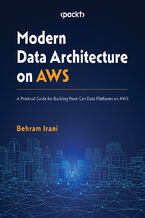 Every organization wants an agile, performant, and cost-effective data platform that meets all their current and future business needs. Purpose-built AWS analytics services and their features play a big part in building such a modern data platform. This book brings to you all the design and architectural patterns that’ll help you achieve this goal.
Every organization wants an agile, performant, and cost-effective data platform that meets all their current and future business needs. Purpose-built AWS analytics services and their features play a big part in building such a modern data platform. This book brings to you all the design and architectural patterns that’ll help you achieve this goal.-
- PDF + ePub 116 pkt
(29,90 zł najniższa cena z 30 dni)
116.10 zł
129.00 zł (-10%) -
-
Promocja Promocja 2za1
 This book comes with practical examples and exercises to help you keep your code maintainable while working on a Rails application by demonstrating the useful design patterns and exploring the common code abstractions.
This book comes with practical examples and exercises to help you keep your code maintainable while working on a Rails application by demonstrating the useful design patterns and exploring the common code abstractions.-
- PDF + ePub 125 pkt
(29,90 zł najniższa cena z 30 dni)
125.10 zł
139.00 zł (-10%) -
-
Promocja Promocja 2za1
 Explore mathematical concepts and approaches to modeling, alongside machine learning techniques, to understand the relevance of models in solving business problems. This book covers various models, tools to uncover meaningful insights, and the perfect blend of machine learning and mathematical modeling to enhance your data science journey.
Explore mathematical concepts and approaches to modeling, alongside machine learning techniques, to understand the relevance of models in solving business problems. This book covers various models, tools to uncover meaningful insights, and the perfect blend of machine learning and mathematical modeling to enhance your data science journey.-
- PDF + ePub 125 pkt
(29,90 zł najniższa cena z 30 dni)
125.10 zł
139.00 zł (-10%) -
-
Promocja Promocja 2za1
 Strategizing Continuous Delivery in Cloud will help you work on CI/CD and cloud-native together ensuring that your teams can operate in different types of cloud environments. You’ll be capable of releasing more efficient software by upgrading and modernizing continuous delivery.
Strategizing Continuous Delivery in Cloud will help you work on CI/CD and cloud-native together ensuring that your teams can operate in different types of cloud environments. You’ll be capable of releasing more efficient software by upgrading and modernizing continuous delivery.-
- PDF + ePub 116 pkt
(29,90 zł najniższa cena z 30 dni)
116.10 zł
129.00 zł (-10%) -
-
Promocja Promocja 2za1
 This concise book equips you with the knowledge and practices needed to establish and maintain an effective information security management system. The chapters provide insights into ISO/IEC 27001/27002:2022, risk management, ISMS development, incident management, audit processes, and strategies for continuous improvement.
This concise book equips you with the knowledge and practices needed to establish and maintain an effective information security management system. The chapters provide insights into ISO/IEC 27001/27002:2022, risk management, ISMS development, incident management, audit processes, and strategies for continuous improvement.-
- PDF + ePub 116 pkt
(29,90 zł najniższa cena z 30 dni)
116.10 zł
129.00 zł (-10%) -
O autorze książki
Edward Capriolo, Brian Fitzpatrick - pozostałe książki
-
Promocja Promocja 2za1
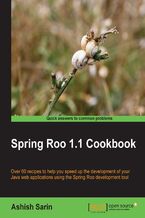 Spring Roo is an easy-to-use productivity tool for rapidly developing Java enterprise applications using well-recognized frameworks such as Spring, Hibernate, AspectJ, Spring Web Flow, Spring Security, GWT, and so on. Spring Roo takes care of creating maven-enabled projects, enterprise application architecture based on your choice of technologies,
Spring Roo is an easy-to-use productivity tool for rapidly developing Java enterprise applications using well-recognized frameworks such as Spring, Hibernate, AspectJ, Spring Web Flow, Spring Security, GWT, and so on. Spring Roo takes care of creating maven-enabled projects, enterprise application architecture based on your choice of technologies,-
- PDF + ePub + Mobi 143 pkt
(29,90 zł najniższa cena z 30 dni)
143.10 zł
159.00 zł (-10%) -
-
Promocja Promocja 2za1
 Apache Open For Business (OFBiz) is an enterprise resource planning (ERP) system that provides a common data model and an extensive set of business processes. But without proper guidance on developing performance-critical applications, it is easy to make the wrong design and technology decisions. The power and promise of Apache OFBiz is comprehensi
Apache Open For Business (OFBiz) is an enterprise resource planning (ERP) system that provides a common data model and an extensive set of business processes. But without proper guidance on developing performance-critical applications, it is easy to make the wrong design and technology decisions. The power and promise of Apache OFBiz is comprehensi-
- PDF + ePub + Mobi 125 pkt
(29,90 zł najniższa cena z 30 dni)
125.10 zł
139.00 zł (-10%) -
-
Promocja Promocja 2za1
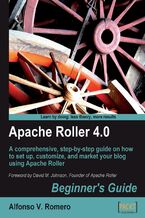 Apache Roller enables you to build a fully-featured, multi-user blog server apt for all kinds of blogging sites. It is an ideal tool to create your own blogging network with unlimited users and blogs, forums, photo galleries, and more! While it is exciting to have a list of interesting features it can offer you, it might be a little difficult to ge
Apache Roller enables you to build a fully-featured, multi-user blog server apt for all kinds of blogging sites. It is an ideal tool to create your own blogging network with unlimited users and blogs, forums, photo galleries, and more! While it is exciting to have a list of interesting features it can offer you, it might be a little difficult to ge-
- PDF + ePub + Mobi 125 pkt
(29,90 zł najniższa cena z 30 dni)
125.10 zł
139.00 zł (-10%) -
-
Promocja Promocja 2za1
 While Tomcat is one of the most popular servlet containers, its inner workings still remain a mystery to many developers. If you only have a superficial familiarity of how this container actually functions, much of its power remains untapped and underutilized. This book will provide you with all that you need to undertand how to effectively use Apa
While Tomcat is one of the most popular servlet containers, its inner workings still remain a mystery to many developers. If you only have a superficial familiarity of how this container actually functions, much of its power remains untapped and underutilized. This book will provide you with all that you need to undertand how to effectively use Apa-
- PDF + ePub + Mobi 125 pkt
(29,90 zł najniższa cena z 30 dni)
125.10 zł
139.00 zł (-10%) -
-
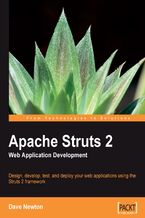 Struts 2.1 is a modern, extensible, agile web application framework suitable for both small- and large-scale web applications.The book begins with a comprehensive look at Struts 2.1 basics, interspersed with detours into more advanced development topics. You'll learn about configuring Struts 2.1 actions, results, and interceptors via both XML and J
Struts 2.1 is a modern, extensible, agile web application framework suitable for both small- and large-scale web applications.The book begins with a comprehensive look at Struts 2.1 basics, interspersed with detours into more advanced development topics. You'll learn about configuring Struts 2.1 actions, results, and interceptors via both XML and J-
- PDF + ePub + Mobi 84 pkt
Niedostępna
-
-
Promocja Promocja 2za1
 Developing powerful web applications with clean, manageable code makes the maintenance process much easier. Aspect-Oriented Programming (AOP) is the easiest and quickest way to achieve such results. Spring is the only Java framework to offer AOP features. The combined power of Spring and AOP gives a powerful and flexible platform to develop and mai
Developing powerful web applications with clean, manageable code makes the maintenance process much easier. Aspect-Oriented Programming (AOP) is the easiest and quickest way to achieve such results. Spring is the only Java framework to offer AOP features. The combined power of Spring and AOP gives a powerful and flexible platform to develop and mai-
- PDF + ePub + Mobi 107 pkt
Spring 2.5 Aspect Oriented Programming. Create dynamic, feature-rich, and robust enterprise applications using the Spring framework
Massimiliano Dess?É?íÂ!¨, Brian Fitzpatrick, Massimiliano Dessi
(29,90 zł najniższa cena z 30 dni)
107.10 zł
119.00 zł (-10%) -
-
Promocja Promocja 2za1
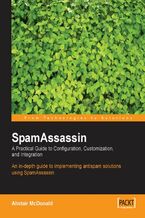 As a busy administrator, you know Spam is a major distraction in todays network. The effects range from inappropriate content arriving in the mailboxes up to contact email addresses placed on a website being deluged with unsolicited mail, causing valid enquiries and sales leads to be lost and wasting employee time. The perception of the problem of
As a busy administrator, you know Spam is a major distraction in todays network. The effects range from inappropriate content arriving in the mailboxes up to contact email addresses placed on a website being deluged with unsolicited mail, causing valid enquiries and sales leads to be lost and wasting employee time. The perception of the problem of-
- PDF + ePub + Mobi 107 pkt
(29,90 zł najniższa cena z 30 dni)
107.10 zł
119.00 zł (-10%) -
-
Promocja Promocja 2za1
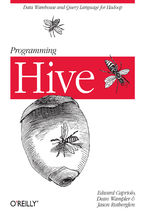 Need to move a relational database application to Hadoop? This comprehensive guide introduces you to Apache Hive, Hadoop’s data warehouse infrastructure. You’ll quickly learn how to use Hive’s SQL dialect—HiveQL—to summarize, query, and analyze large datasets stored in Hadoop’s distributed filesystem.This example-driven guide shows you how to set u
Need to move a relational database application to Hadoop? This comprehensive guide introduces you to Apache Hive, Hadoop’s data warehouse infrastructure. You’ll quickly learn how to use Hive’s SQL dialect—HiveQL—to summarize, query, and analyze large datasets stored in Hadoop’s distributed filesystem.This example-driven guide shows you how to set u-
- ePub + Mobi 135 pkt
(126,65 zł najniższa cena z 30 dni)
135.15 zł
159.00 zł (-15%) -
-
Promocja Promocja 2za1
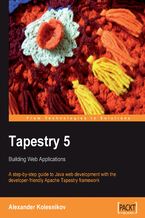
-
- PDF + ePub + Mobi 107 pkt
(29,90 zł najniższa cena z 30 dni)
107.10 zł
119.00 zł (-10%) -
Ebooka "Cassandra High Performance Cookbook. You can mine deep into the full capabilities of Apache Cassandra using the 150+ recipes in this indispensable Cookbook. From configuring and tuning to using third party applications, this is the ultimate guide" przeczytasz na:
-
czytnikach Inkbook, Kindle, Pocketbook, Onyx Boox i innych
-
systemach Windows, MacOS i innych
-
systemach Windows, Android, iOS, HarmonyOS
-
na dowolnych urządzeniach i aplikacjach obsługujących formaty: PDF, EPub, Mobi
Masz pytania? Zajrzyj do zakładki Pomoc »
Audiobooka "Cassandra High Performance Cookbook. You can mine deep into the full capabilities of Apache Cassandra using the 150+ recipes in this indispensable Cookbook. From configuring and tuning to using third party applications, this is the ultimate guide" posłuchasz:
-
w aplikacji Ebookpoint na Android, iOS, HarmonyOs
-
na systemach Windows, MacOS i innych
-
na dowolonych urządzeniach i aplikacjach obsługujących format MP3 (pliki spakowane w ZIP)
Masz pytania? Zajrzyj do zakładki Pomoc »
Kurs Video "Cassandra High Performance Cookbook. You can mine deep into the full capabilities of Apache Cassandra using the 150+ recipes in this indispensable Cookbook. From configuring and tuning to using third party applications, this is the ultimate guide" zobaczysz:
-
w aplikacjach Ebookpoint i Videopoint na Android, iOS, HarmonyOs
-
na systemach Windows, MacOS i innych z dostępem do najnowszej wersji Twojej przeglądarki internetowej
Szczegóły książki
- Tytuł oryginału:
- Cassandra High Performance Cookbook. You can mine deep into the full capabilities of Apache Cassandra using the 150+ recipes in this indispensable Cookbook. From configuring and tuning to using third party applications, this is the ultimate guide.
- ISBN Ebooka:
- 978-18-495-1513-9, 9781849515139
- Data wydania ebooka :
-
2011-07-15
 Data wydania ebooka często jest dniem wprowadzenia tytułu do sprzedaży i może nie być równoznaczna
z datą wydania książki papierowej. Dodatkowe informacje możesz znaleźć w darmowym fragmencie.
Jeśli masz wątpliwości skontaktuj się z nami sklep@ebookpoint.pl.
Data wydania ebooka często jest dniem wprowadzenia tytułu do sprzedaży i może nie być równoznaczna
z datą wydania książki papierowej. Dodatkowe informacje możesz znaleźć w darmowym fragmencie.
Jeśli masz wątpliwości skontaktuj się z nami sklep@ebookpoint.pl.
- Język publikacji:
- angielski
- Rozmiar pliku Pdf:
- 2.7MB
- Rozmiar pliku ePub:
- 3.2MB
- Rozmiar pliku Mobi:
- 5.4MB
Spis treści książki
- Cassandra High Performance Cookbook
- Table of Contents
- Cassandra High Performance Cookbook
- Credits
- About the Author
- About the Reviewers
- www.PacktPub.com
- Support files, eBooks, discount offers and more
- Why Subscribe?
- Free Access for Packt account holders
- Support files, eBooks, discount offers and more
- Preface
- What this book covers
- What you need for this book
- Who this book is for
- Conventions
- Reader feedback
- Customer support
- Downloading the example code for this book
- Errata
- Piracy
- Questions
- 1. Getting Started
- Introduction
- A simple single node Cassandra installation
- Getting ready
- How to do it...
- How it works...
- Theres more...
- See also...
- Reading and writing test data using the command-line interface
- How to do it...
- How it works...
- See also...
- Running multiple instances on a single machine
- How to do it...
- How it works...
- See also...
- Scripting a multiple instance installation
- How to do it...
- How it works...
- Setting up a build and test environment for tasks in this book
- Getting ready
- How to do it...
- How it works...
- There's more...
- Running in the foreground with full debugging
- How to do it...
- How it works...
- There's more...
- Calculating ideal Initial Tokens for use with Random Partitioner
- Getting ready
- How to do it...
- How it works
- There's more...
- See also...
- Choosing Initial Tokens for use with Partitioners that preserve ordering
- How to do it...
- How it works...
- There's more...
- Insight into Cassandra with JConsole
- Getting ready
- How to do it...
- How it works...
- See also...
- Connecting with JConsole over a SOCKS proxy
- Getting ready
- How to do it...
- How it works...
- Connecting to Cassandra with Java and Thrift
- Getting ready
- How to do it...
- How it works...
- See also...
- 2. The Command-line Interface
- Connecting to Cassandra with the CLI
- How to do it...
- How it works...
- Creating a keyspace from the CLI
- How to do it...
- How it works...
- There's more...
- See also...
- Creating a column family with the CLI
- Getting ready
- How to do it...
- See also...
- Describing a keyspace
- How to do it...
- How it works...
- Writing data with the CLI
- Getting ready
- How to do it...
- How it works...
- There's more...
- Reading data with the CLI
- Getting ready
- How to do it...
- How it works...
- See also...
- Deleting rows and columns from the CLI
- How to do it...
- How it works...
- See also...
- Listing and paginating all rows in a column family
- Getting ready
- How to do it...
- How it works...
- Dropping a keyspace or a column family
- How to do it...
- How it works...
- See also...
- CLI operations with super columns
- How to do it...
- How it works...
- There's more...
- Using the assume keyword to decode column names or column values
- How to do it...
- How it works...
- There's more...
- Supplying time to live information when inserting columns
- How to do it...
- See also...
- Using built-in CLI functions
- How to do it...
- How it works...
- Using column metadata and comparators for type enforcement
- How to do it...
- How it works...
- See also...
- Changing the consistency level of the CLI
- How to do it...
- How it works...
- See also...
- Getting help from the CLI
- How to do it...
- How it works...
- Loading CLI statements from a file
- How to do it...
- How it works...
- There's more...
- Connecting to Cassandra with the CLI
- 3. Application Programmer Interface
- Introduction
- Connecting to a Cassandra server
- How to do it...
- How it works...
- There's more
- Creating a keyspace and column family from the client
- How to do it...
- How it works...
- See also...
- Using MultiGet to limit round trips and overhead
- How to do it...
- How it works...
- Writing unit tests with an embedded Cassandra server
- How to do it...
- How it works...
- See also...
- Cleaning up data directories before unit tests
- Getting ready
- How to do it...
- How it works...
- Generating Thrift bindings for other languages (C++, PHP, and others)
- Getting ready
- How to do it...
- How it works...
- Using the Cassandra Storage Proxy "Fat Client"
- How to do it...
- How it works...
- There's more...
- Using range scans to find and remove old data
- How to do it...
- How it works...
- There's more...
- See also...
- Iterating all the columns of a large key
- How to do it...
- How it works...
- Slicing columns in reverse
- Getting ready
- How to do it...
- How it works...
- Batch mutations to improve insert performance and code robustness
- How to do it...
- How it works...
- See also...
- Using TTL to create columns with self-deletion times
- How to do it...
- How it works...
- See also...
- Working with secondary indexes
- Getting ready
- How to do it...
- How it works...
- See also...
- 4. Performance Tuning
- Introduction
- Choosing an operating system and distribution
- How to do it...
- How it works...
- There's more...
- Choosing a Java Virtual Machine
- How to do it...
- There's more...
- See also...
- Using a dedicated Commit Log disk
- Getting ready
- How to do it...
- How it works...
- See also...
- Choosing a high performing RAID level
- Getting ready
- How to do it...
- How it works...
- There's more...
- Software v/s hardware RAID
- Disk performance testing
- See also...
- File system optimization for hard disk performance
- Getting ready
- How to do it...
- How it works...
- Boosting read performance with the Key Cache
- Getting ready
- How to do it...
- How it works
- There's more...
- See also...
- Boosting read performance with the Row Cache
- How to do it...
- How it works...
- There's more...
- Disabling Swap Memory for predictable performance
- How to do it...
- How it works...
- See also...
- Stopping Cassandra from using swap without disabling it system-wide
- Getting ready
- How to do it...
- Enabling Memory Mapped Disk modes
- Getting ready
- How to do it...
- How it works...
- Tuning Memtables for write-heavy workloads
- How to do it...
- How it works...
- There's more...
- See also...
- Saving memory on 64 bit architectures with compressed pointers
- Getting ready
- How to do it...
- How it works...
- Tuning concurrent readers and writers for throughput
- How to do it...
- How it works...
- Setting compaction thresholds
- How to do it...
- How it works...
- There's more...
- See also...
- Garbage collection tuning to avoid JVM pauses
- How to do it...
- How it works...
- There's more...
- Large memory systems
- See also...
- There's more
- Raising the open file limit to deal with many clients
- How to do it...
- How it works...
- There's more...
- Increasing performance by scaling up
- How to do it...
- How it works...
- Enabling Network Time Protocol on servers and clients
- Getting ready
- How to do it...
- How it works...
- 5. Consistency, Availability, and Partition Tolerance with Cassandra
- Introduction
- Working with the formula for strong consistency
- Getting ready
- How to do it...
- How it works...
- See also...
- Supplying the timestamp value with write requests
- How to do it...
- How it works...
- There's more...
- Disabling the hinted handoff mechanism
- How to do it...
- How it works...
- There's more...
- Adjusting read repair chance for less intensive data reads
- Getting ready
- How to do it...
- How it works...
- There's more...
- See also...
- Confirming schema agreement across the cluster
- How to do it...
- How it works...
- There's more...
- Adjusting replication factor to work with quorum
- How to do it...
- How it works...
- See also...
- Using write consistency ONE, read consistency ONE for low latency operations
- How to do it...
- How it works...
- There's more...
- Using write consistency QUORUM, read consistency QUORUM for strong consistency
- Getting ready
- How to do it...
- How it works...
- Mixing levels write consistency QUORUM, read consistency ONE
- Getting ready
- How to do it...
- How it works...
- Choosing consistency over availability consistency ALL
- How to do it...
- How it works...
- Choosing availability over consistency with write consistency ANY
- How to do it...
- How it works...
- Demonstrating how consistency is not a lock or a transaction
- How to do it...
- How it works...
- See also...
- 6. Schema Design
- Introduction
- Saving disk space by using small column names
- How to do it...
- How it works...
- Serializing data into large columns for smaller index sizes
- How to do it...
- How it works...
- There's more...
- Storing time series data effectively
- How to do it...
- How it works...
- Using Super Columns for nested maps
- How to do it...
- How it works...
- There's more...
- Using a lower Replication Factor for disk space saving and performance enhancements
- How to do it...
- How it works...
- There's more...
- See also...
- Hybrid Random Partitioner using Order Preserving Partitioner
- Getting ready
- How to do it...
- How it works...
- There's more...
- Scripting a multiple instance installation with OOP
- Using different hash algorithms
- Storing large objects
- How to do it...
- How it works...
- There's more...
- Using Cassandra for distributed caching
- How to do it...
- How it works...
- Storing large or infrequently accessed data in a separate column family
- How to do it...
- How it works...
- Storing and searching edge graph data in Cassandra
- Getting ready
- How to do it...
- How it works...
- Developing secondary data orderings or indexes
- Getting ready
- How to do it...
- How it works...
- See also...
- 7. Administration
- Defining seed nodes for Gossip Communication
- Getting ready
- How to do it...
- There's more
- IP vs Hostname
- Keep the seed list synchronized
- Seed nodes do not auto bootstrap
- Choosing the correct number of seed nodes
- Nodetool Move: Moving a node to a specific ring location
- Getting ready
- How to do it...
- How it works...
- Nodetool Remove: Removing a downed node
- How to do it...
- How it works...
- See also...
- Nodetool Decommission: Removing a live node
- How to do it...
- How it works...
- Joining nodes quickly with auto_bootstrap set to false
- Generating SSH keys for password-less interaction
- How to do it...
- How it works...
- There's more...
- Normal write traffic
- Read Repair
- Anti-Entropy Repair
- How to do it...
- How it works...
- These is more
- Copying the data directory to new hardware
- Getting ready
- How to do it...
- How it works...
- There's more
- A node join using external data copy methods
- Getting ready
- How to do it...
- How it works...
- Nodetool Repair: When to use anti-entropy repair
- How to do it...
- How it works...
- There's more...
- Raising the Replication Factor
- Joining nodes without auto-bootstrap
- Loss of corrupted files
- Nodetool Drain: Stable files on upgrade
- How to do it...
- How it works...
- Lowering gc_grace for faster tombstone cleanup
- How to do it...
- How it works...
- There's more...
- Data resurrection
- Scheduling Major Compaction
- How to do it...
- How it works...
- There's more...
- Using nodetool snapshot for backups
- Getting ready
- How to do it...
- How it works...
- There's more...
- See also...
- Clearing snapshots with nodetool clearsnapshot
- Getting ready
- How to do it...
- How it works...
- Restoring from a snapshot
- How to do it...
- How it works...
- There's more...
- Exporting data to JSON with sstable2json
- How to do it...
- How it works...
- There's more...
- Extracting specific keys
- Excluding specific keys
- Saving the exported JSON to a file
- Using the xxd command to decode hex values
- Nodetool cleanup: Removing excess data
- How to do it...
- How it works...
- There's more...
- Topology changes
- Hinted handoff and write consistency ANY
- See also...
- Nodetool Compact: Defragment data and remove deleted data from disk
- How to do it...
- How it works...
- See also...
- Defining seed nodes for Gossip Communication
- 8. Multiple Datacenter Deployments
- Changing debugging to determine where read operations are being routed
- How to do it...
- How it works...
- See also...
- Using IPTables to simulate complex network scenarios in a local environment
- Getting ready
- How to do it...
- How it works...
- Choosing IP addresses to work with RackInferringSnitch
- Getting ready
- How to do it...
- How it works...
- There's more...
- See also...
- Scripting a multiple datacenter installation
- Getting ready
- How to do it...
- How it works...
- Determining natural endpoints, datacenter, and rack for a given key
- How to do it...
- How it works...
- See also...
- Manually specifying Rack and Datacenter configuration with a property file snitch
- Getting ready
- How to do it...
- How it works...
- There's more...
- Troubleshooting dynamic snitch using JConsole
- Getting ready
- How to do it...
- How it works...
- Quorum operations in multi-datacenter environments
- Getting ready
- How it works...
- Using traceroute to troubleshoot latency between network devices
- How to do it...
- How it works...
- Ensuring bandwidth between switches in multiple rack environments
- How to do it...
- There's more...
- Increasing rpc_timeout for dealing with latency across datacenters
- How to do it...
- How it works...
- Changing consistency level from the CLI to test various consistency levels with multiple datacenter deployments
- Getting ready
- How to do it...
- How it works...
- Using the consistency levels TWO and THREE
- Getting ready
- How to do it...
- How it works...
- Calculating Ideal Initial Tokens for use with Network Topology Strategy and Random Partitioner
- Getting ready
- How to do it...
- How it works...
- There's more...
- More than two datacenters
- Datacenters with differing numbers of nodes
- Endpoint Snitch
- See also...
- Changing debugging to determine where read operations are being routed
- 9. Coding and Internals
- Introduction
- Installing common development tools
- How to do it...
- How it works...
- Building Cassandra from source
- How to do it...
- How it works...
- See also...
- Creating your own type by sub classing abstract type
- How to do it...
- How it works...
- See also...
- Using the validation to check data on insertion
- Getting ready
- How to do it...
- How it works...
- Communicating with the Cassandra developers and users through IRC and e-mail
- How to do it...
- How it works...
- Generating a diff using subversion's diff feature
- How to do it...
- How it works...
- There's more...
- See also...
- Applying a diff using the patch command
- Before you begin...
- How to do it...
- How it works...
- Using strings and od to quickly search through data files
- How to do it...
- How it works...
- Customizing the sstable2json export utility
- How to do it...
- How it works...
- There's more...
- Configure index interval ratio for lower memory usage
- How to do it...
- How it works...
- Increasing phi_convict_threshold for less reliable networks
- How to do it...
- How it works...
- There's more...
- Using the Cassandra maven plugin
- Getting ready
- How to do it...
- How it works...
- There's more...
- 10. Libraries and Applications
- Introduction
- Building the contrib stress tool for benchmarking
- Getting ready
- How to do it...
- How it works...
- See also...
- Inserting and reading data with the stress tool
- Before you begin...
- How to do it...
- How it works...
- There's more...
- See also...
- Running the Yahoo! Cloud Serving Benchmark
- How to do it...
- How it works...
- There's more...
- Hector, a high-level client for Cassandra
- How to do it...
- How it works...
- There's more...
- Doing batch mutations with Hector
- How to do it...
- How it works...
- Cassandra with Java Persistence Architecture (JPA)
- Before you begin...
- How to do it...
- How it works...
- There's more...
- Setting up Solandra for full text indexing with a Cassandra backend
- How to do it...
- How it works...
- Setting up Zookeeper to support Cages for transactional locking
- How to do it...
- How it works...
- See also...
- Using Cages to implement an atomic read and set
- Getting ready
- How to do it...
- How it works...
- There's more...
- Using Groovandra as a CLI alternative
- How to do it...
- How it works...
- Searchable log storage with Logsandra
- Getting ready
- How to do it...
- How it works...
- There's more...
- 11. Hadoop and Cassandra
- Introduction
- A pseudo-distributed Hadoop setup
- How to do it...
- How it works...
- There's more...
- A Map-only program that reads from Cassandra using the ColumnFamilyInputFormat
- How to do it...
- How it works...
- See also...
- A Map-only program that writes to Casandra using the CassandraOutputFormat
- Getting ready
- How to do it...
- How it works...
- Using MapReduce to do grouping and counting with Cassandra input and output
- Getting ready
- How to do it...
- How it works...
- Setting up Hive with Cassandra Storage Handler support
- Getting ready
- How to do it...
- How it works...
- See also...
- Defining a Hive table over a Cassandra Column Family
- Getting ready
- How to do it...
- How it works...
- See also...
- Joining two Column Families with Hive
- Getting ready
- How to do it...
- How it works...
- Grouping and counting column values with Hive
- How to do it...
- How it works...
- See also...
- Co-locating Hadoop Task Trackers on Cassandra nodes
- How to do it...
- How it works...
- See also...
- Setting up a "Shadow" data center for running only MapReduce jobs
- Getting ready
- How to do it...
- How it works...
- There's more...
- Setting up DataStax Brisk the combined stack of Cassandra, Hadoop, and Hive
- How to do it...
- How it works
- 12. Collecting and Analyzing Performance Statistics
- Finding bottlenecks with nodetool tpstats
- How to do it...
- How it works...
- There's more...
- Using nodetool cfstats to retrieve column family statistics
- How to do it...
- How it works...
- See also...
- Monitoring CPU utilization
- How to do it...
- How it works...
- See also...
- Adding read/write graphs to find active column families
- How to do it...
- How it works...
- There's more...
- Using Memtable graphs to profile when and why they flush
- How it works...
- There's more...
- See also...
- Graphing SSTable count
- How to do it...
- There's more...
- Monitoring disk utilization and having a performance baseline
- How to do it...
- How it works...
- There's more...
- See also...
- How to do it...
- How it works...
- See also...
- Monitoring compaction by graphing its activity
- How it works...
- There's more...
- See also...
- Using nodetool compaction stats to check the progress of compaction
- How to do it...
- How it works...
- Graphing column family statistics to track average/max row sizes
- How to do it...
- Using latency graphs to profile time to seek keys
- How to do it...
- How it works...
- Tracking the physical disk size of each column family over time
- How to do it...
- How it works...
- Using nodetool cfhistograms to see the distribution of query latencies
- How to do it...
- How it works...
- See also...
- Tracking open networking connections
- How to do it...
- How it works...
- There's more...
- Finding bottlenecks with nodetool tpstats
- 13. Monitoring Cassandra Servers
- Introduction
- Forwarding Log4j logs to a central sever
- Getting ready
- How to do it...
- How it works...
- Theres more....
- Using top to understand overall performance
- How to do it...
- How it works...
- There's more...
- Using iostat to monitor current disk performance
- Getting ready
- How to do it...
- How it works...
- See also...
- Using sar to review performance over time
- Getting ready
- How to do it...
- How it works...
- Using JMXTerm to access Cassandra JMX
- Getting ready
- How to do it...
- How it works...
- See also...
- Monitoring the garbage collection events
- How to do it...
- How it works...
- Theres more...
- Using tpstats to find bottlenecks
- How to do it...
- How it works...
- See also...
- Creating a Nagios Check Script for Cassandra
- How to do it...
- Keep an eye out for large rows with compaction limits
- How to do it...
- How it works...
- Reviewing network traffic with IPTraf
- Getting ready
- How to do it...
- How it works...
- Keep on the lookout for dropped messages
- How to do it...
- How it works...
- Inspecting column families for dangerous conditions
- How to do it...
- How it works...
- Index
Packt Publishing - inne książki
-
Promocja Promocja 2za1
 API Security for White Hat Hackers is a comprehensive guide that simplifies API security by showing you how to identify and fix vulnerabilities. From emerging threats to best practices, this book helps you defend and safeguard your APIs.
API Security for White Hat Hackers is a comprehensive guide that simplifies API security by showing you how to identify and fix vulnerabilities. From emerging threats to best practices, this book helps you defend and safeguard your APIs.-
- PDF + ePub 116 pkt
(29,90 zł najniższa cena z 30 dni)
116.10 zł
129.00 zł (-10%) -
-
Promocja Promocja 2za1
 Polars Cookbook is a compilation of practical recipes for efficient data wrangling using Python Polars. The book teaches you how to solve common data problems using Polars, create solutions tailored towards your specific use case, and more.
Polars Cookbook is a compilation of practical recipes for efficient data wrangling using Python Polars. The book teaches you how to solve common data problems using Polars, create solutions tailored towards your specific use case, and more.-
- PDF + ePub 125 pkt
(29,90 zł najniższa cena z 30 dni)
125.10 zł
139.00 zł (-10%) -
-
 Azure OpenAI is an advanced LLM built on top of Microsoft Azure platform. It is revolutionizing Microsoft's own products like GitHub Copilot, M365 Copilot, Bing Chat. This book covers comprehensive exploration of Azure OpenAI, security & safety measures, fine-tuning, and advanced prompt engineering for constructing GenAI applications.
Azure OpenAI is an advanced LLM built on top of Microsoft Azure platform. It is revolutionizing Microsoft's own products like GitHub Copilot, M365 Copilot, Bing Chat. This book covers comprehensive exploration of Azure OpenAI, security & safety measures, fine-tuning, and advanced prompt engineering for constructing GenAI applications.Niedostępna
-
 This book is a complete reference for Azure Bicep, covering everything from the fundamentals to complex topics. It will teach you how to design and deploy Azure resources with the power of Azure Bicep, speeding up the development and deployment processes in Microsoft Azure while helping you avoid human errors in your code.
This book is a complete reference for Azure Bicep, covering everything from the fundamentals to complex topics. It will teach you how to design and deploy Azure resources with the power of Azure Bicep, speeding up the development and deployment processes in Microsoft Azure while helping you avoid human errors in your code.Niedostępna
-
 Transformers have started a new era in AI, especially with the introduction of Large Language Models, marking a significant global change. Make the most of their benefits for predicting time series data.
Transformers have started a new era in AI, especially with the introduction of Large Language Models, marking a significant global change. Make the most of their benefits for predicting time series data.Niedostępna
-
Promocja Promocja 2za1
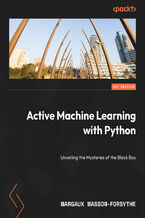 Hone your machine learning skills to unlock robust models with less data through active machine learning. Tame messy datasets, conquer concept drift, and drive ML productivity with Python's active learning toolkit.
Hone your machine learning skills to unlock robust models with less data through active machine learning. Tame messy datasets, conquer concept drift, and drive ML productivity with Python's active learning toolkit.-
- PDF + ePub 116 pkt
(29,90 zł najniższa cena z 30 dni)
116.10 zł
129.00 zł (-10%) -
-
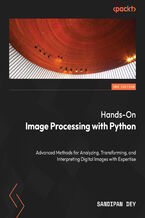 The book covers how to use the popular libraries in python to solve image processing problems (e.g., enhancement, restoration, segmentation, classification, object detection) and learn how to implement complex algorithms using classical, Machine learning and recent Deep Learning models.
The book covers how to use the popular libraries in python to solve image processing problems (e.g., enhancement, restoration, segmentation, classification, object detection) and learn how to implement complex algorithms using classical, Machine learning and recent Deep Learning models.Niedostępna
-
 This book walks through the entire process of ML model development, from principles to practice. It begins with a deep dive into responsible AI principles with case studies, then covers techniques and tools for evaluating and remediating ML data and models using the TensorFlow toolkit, and finally discusses topics at the intersection of AI and society.
This book walks through the entire process of ML model development, from principles to practice. It begins with a deep dive into responsible AI principles with case studies, then covers techniques and tools for evaluating and remediating ML data and models using the TensorFlow toolkit, and finally discusses topics at the intersection of AI and society.Niedostępna
-
 GANs, a widely acclaimed category within Generative AI, epitomize the forefront of deep learning. This comprehensive book will guide you from constructing your initial GAN to mastering its intricacies. Moreover, it delves into advanced territories, demystifying the integration of GAN components in groundbreaking models like MUSE and Stable Diffusion.
GANs, a widely acclaimed category within Generative AI, epitomize the forefront of deep learning. This comprehensive book will guide you from constructing your initial GAN to mastering its intricacies. Moreover, it delves into advanced territories, demystifying the integration of GAN components in groundbreaking models like MUSE and Stable Diffusion.Niedostępna
-
Promocja Promocja 2za1
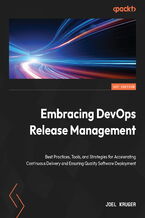 Learn how to transform your SDLC fast by developing the key skills to shift left and complete projects in record time. This book will give you the knowledge to start your own DevOps release management initiative and transform your company.
Learn how to transform your SDLC fast by developing the key skills to shift left and complete projects in record time. This book will give you the knowledge to start your own DevOps release management initiative and transform your company.-
- PDF + ePub 107 pkt
(29,90 zł najniższa cena z 30 dni)
107.10 zł
119.00 zł (-10%) -
Dzięki opcji "Druk na żądanie" do sprzedaży wracają tytuły Grupy Helion, które cieszyły sie dużym zainteresowaniem, a których nakład został wyprzedany.
Dla naszych Czytelników wydrukowaliśmy dodatkową pulę egzemplarzy w technice druku cyfrowego.
Co powinieneś wiedzieć o usłudze "Druk na żądanie":
- usługa obejmuje tylko widoczną poniżej listę tytułów, którą na bieżąco aktualizujemy;
- cena książki może być wyższa od początkowej ceny detalicznej, co jest spowodowane kosztami druku cyfrowego (wyższymi niż koszty tradycyjnego druku offsetowego). Obowiązująca cena jest zawsze podawana na stronie WWW książki;
- zawartość książki wraz z dodatkami (płyta CD, DVD) odpowiada jej pierwotnemu wydaniu i jest w pełni komplementarna;
- usługa nie obejmuje książek w kolorze.
Masz pytanie o konkretny tytuł? Napisz do nas: sklep@ebookpoint.pl
Książka drukowana













Oceny i opinie klientów: Cassandra High Performance Cookbook. You can mine deep into the full capabilities of Apache Cassandra using the 150+ recipes in this indispensable Cookbook. From configuring and tuning to using third party applications, this is the ultimate guide Edward Capriolo, Brian Fitzpatrick (0) Weryfikacja opinii następuje na podstawie historii zamowień na koncie Użytkownika umiejszczającego opinię.
Weryfikacja opinii następuje na podstawie historii zamowień na koncie Użytkownika umiejszczającego opinię.